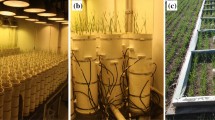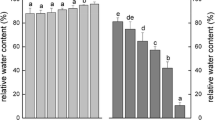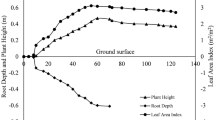Abstract
Soil moisture flux to root surface is considered the main determining factor of the transpiration intensity of plants. This assumption is valid not only in optimal plant physiological conditions without any physical barrier for the evaporation from the leaves, but in climatic drought as well, when high usable soil water amount cannot supply the evapo-transpiration intensity of plant. A new algorithm we built up describing the plant adaptation in climatic drought when stoma’s closure and reduction of plant’s potential evapo-transpiration (PET) starts. The adaptation algorithm of Doorenbos et al. (1978) is developed further defining that soil moisture content initiating the stomata’s closure. The critical soil moisture content is varying according to the PET, and drought tolerance of plant. If soil moisture content is less than the critical one, the plant evapo-transpiration (ET) can be highly different in the drought tolerance plant groups. The new drought tolerance algorithm is applied to maize field plots on chernozem soil of the experimental station of the Debrecen University, in East Hungary. Simulated soil water storages are compared to measured ones of a field plot treatment in five consecutive years. The soil moisture content profiles are measured with a BR-150 capacitance probe (Andrén et al. 1991). Differences between measured and simulated soil water storages are not significant in 2003. Simulations indicate low soil water storages in autumn of 2006, and in the first half of 2007 predicting the low maize production realized in 2007. The new plant adaptation algorithm can be used for a climate and soil moisture content sensitive irrigation control as well. The maize production is an illustrative biohydrological example of water flow through the soil-plant-atmosphere continuum.
Similar content being viewed by others
References
Andrén O., Rajkai K. & Kätterer T. 1991. A non-destructive technique for studies of root distribution in relation to soil moisture. Agric. Ecosyst. Environ. 34: 269–278.
Bossel H. 1985. Umweltdynamik te-wi. Verlag GmbH, München, 466 pp.
van Diepen C.A., Rappoldt C., Wolf J. & Van Keulen H. 1988. Crop growth simulation model WOFOST. Documentation version 4.1, Centre for World Food Studies, Wageningen, The Netherlands. 299 pp.
Doorenbos J. & Kassam A.H. 1979. Yield Response to Water. F.A.O., Rome, 193 pp.
Doorenbos J., Kassam A.H., Bentvelder C. & Uittenbogaard G. 1978. Yield Response to Water. U.N. Economic Commission West. Asia, Rome, Italy.
Farkas, Cs., Gyuricza Cs., László P. & Birkás M. 2000: Study of the influence of soil tillage on soil water regime, pp. 251–257. In. Horn R., van den Akker J.J.H. & J. Avidsson (eds), Subsoil Compaction. Advances in Geoecology 32., Catena Verlag, Reiskirchen.
Hanks J. & Ritchie J.T. (eds) 1984. Modelling Plant and Soil Systems. Agronomy series 31. ASA, CSSA, SSSA Publ. Madison, Wisconsin, USA.
Hansen S., Jensen H.E., Nielsen N.E. & Svendsen H. 1990. DAISY — Soil Plant Atmosphere System Model. NPO-Research Report No. A 10. The National Agency of Environmental Protection Copenhagen, Denmark.
Jansson P-E. & Karlberg L. 2001. Coupled heat and mass transfer model for soil-plant-atmosphere systems. Dept. of Land and Water Resour. Engineering, Royal Inst. of Technology, Stockholm. 321 pp.
Jones C.A. & Kiniry J.R. (eds) 1986. CERES-Maize. A Simulation Model of Maize Growth and Development. Texas AmM University Press, College Station.
Kreybig L. 1951. Water and heat management of soils. (A talajok hő- és vízgazdálkodá-sa.). Mezőgazdasági Kiadó, Budapest.
Nyiri L. 1993. Földmüveléstan. Mezőgazda Kiadó, Budapest.
Microsoft Visual Basic 6.3 1987–2001 Microsoft Corp.
Orfánus T., Bedrna Z., Lichner Ľ, Hallett P.D., Kňava K. & Sebíň M. 2008. Spatial variability of water repellency in pine forest soil. Soil Water Res. 3(Spec. Iss. 1): S123–S129.
Rajkai K., Szász G. & Huzsvai L. 2004. Agro-ecological models. 103 pp. (In Hungarian)
Rajkai K. 2008. Soil role in bioclimatology. Soil Water Res. 3(Spec. Iss. 1): S23–S34.
Remson I., Hornberger G.M. & Molz F.J. 1971. Numerical methods in subsurface hydrology. Wiley, New York, p. 389.
Szász G. 1977. Agrometeorology. In the University Notebook Series. Debrecen University, Debrecen, 230 pp. (In Hungarian)
Author information
Authors and Affiliations
Corresponding author
Rights and permissions
About this article
Cite this article
Huzsvai, L., Rajkai, K. Modeling of plant adaptation to climatic drought induced water deficit. Biologia 64, 536–540 (2009). https://doi.org/10.2478/s11756-009-0092-9
Received:
Accepted:
Published:
Issue Date:
DOI: https://doi.org/10.2478/s11756-009-0092-9




